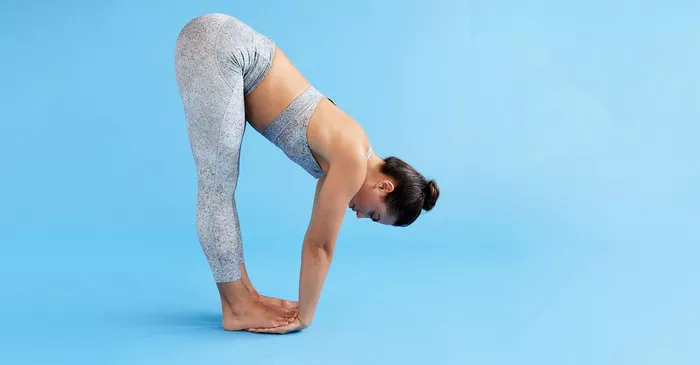Origins and Symbolism
The Big Toe Pose, known as Padangusthasana in Sanskrit, is a fundamental standing forward bend that finds its roots in the ancient practice of Hatha Yoga. “Pada” means foot, “angustha” means big toe, and “asana” means pose. This asana is mentioned in various classical Hatha Yoga texts, such as the “Hatha Yoga Pradipika” and the “Gheranda Samhita,” which underscore its significance in the yogic tradition.
Symbolically, Padangusthasana represents humility and surrender. The act of bending forward and touching the toes signifies bowing down to the Earth and embracing grounding energies. It is a pose that encourages practitioners to release ego and connect with their physicality and breath, embodying the yogic principle of “sthira sukham asanam” — finding steadiness and ease in the pose.
Physical and Mental Benefits
Physical Benefits:
1. Hamstring Stretch: Padangusthasana provides a deep stretch to the hamstrings, helping to improve flexibility and relieve tension in the back of the legs. This is particularly beneficial for athletes and individuals who spend long hours sitting.
2. Calf and Thigh Strengthening: The pose engages the muscles in the calves and thighs, building strength and stability in these areas. Strong legs are crucial for maintaining balance and preventing injuries.
3. Spine Elongation: By lengthening the spine, Big Toe Pose helps alleviate spinal compression, promoting better posture and reducing the risk of back pain.
4. Improved Digestion: The forward bending motion gently massages the abdominal organs, stimulating digestion and helping to alleviate issues such as bloating and constipation.
5. Enhanced Blood Circulation: Inverting the torso increases blood flow to the brain and upper body, providing a rejuvenating effect and promoting cardiovascular health.
Mental Benefits:
1. Stress Relief: The forward bend is inherently calming and helps reduce stress and anxiety by promoting a sense of grounding and introspection. It encourages deep, mindful breathing, which activates the parasympathetic nervous system.
2. Mindfulness and Concentration: Holding the pose requires focus and concentration, enhancing mental clarity and promoting mindfulness. This aspect of the pose is particularly beneficial for those looking to improve their cognitive functions.
3. Emotional Release: Stretching the muscles and releasing physical tension can also facilitate the release of pent-up emotions, leading to an overall sense of emotional well-being.
Variations and Modifications
Variations:
1. Bound Padangusthasana: In this variation, practitioners interlace their fingers around the big toes and pull themselves deeper into the forward bend. This intensifies the stretch in the hamstrings and calves.
2. Supta Padangusthasana: This is a reclining version of the pose, performed lying on the back. It involves lifting one leg at a time and holding the big toe with the corresponding hand, providing a deep hamstring stretch without the weight-bearing aspect.
3. Baddha Padangusthasana: A more advanced variation where the practitioner binds the hands behind the legs while holding the big toes. This requires greater flexibility and balance.
Modifications:
1. Using a Strap: Beginners or those with tight hamstrings can use a yoga strap around the big toes to bridge the gap and maintain proper alignment without straining.
2. Bending the Knees: For those who cannot reach their toes with straight legs, bending the knees slightly can help reduce strain and prevent injury while still gaining the benefits of the forward bend.
3. Support Under Feet: Placing a block or a folded blanket under the feet can elevate the floor and make it easier to reach the toes, especially useful for those with limited flexibility.
Step-by-Step Instructions
1. Preparation: Begin standing in Tadasana (Mountain Pose) with your feet hip-width apart and your weight evenly distributed on both feet.
2. Inhale and Lengthen: Take a deep breath in, lifting your arms overhead to elongate the spine. Engage your quadriceps and lift through the crown of your head.
3. Forward Fold: Exhale as you hinge at the hips and fold forward, keeping your spine long. If necessary, bend your knees slightly to avoid straining your lower back.
4. Reach for the Toes: Once your torso is parallel to the ground, reach down with both hands and grasp your big toes with your index and middle fingers. Your thumbs should rest on top of the toes.
5. Engage the Core: Draw your belly button towards your spine to engage your core muscles and protect your lower back.
6. Deepen the Pose: With each exhale, gently pull your torso closer to your legs, deepening the forward bend. Ensure that your head and neck are relaxed, and your gaze is directed towards your shins.
7. Hold the Pose: Stay in the pose for 5-10 breaths, maintaining steady, even breathing. Focus on lengthening your spine and deepening the stretch with each exhale.
8. Release: To come out of the pose, release your toes and slowly rise back up to a standing position, leading with your chest and keeping your spine long.
Precautions and Contraindications
1. Back Injuries: Individuals with herniated discs or other severe back injuries should avoid this pose or perform it under the guidance of a qualified instructor. The forward bending motion can exacerbate existing conditions.
2. Hamstring Strain: Those with tight hamstrings should be cautious and avoid pushing too hard to reach the toes. Using modifications such as bending the knees or using a strap can help prevent strain.
3. Balance Issues: If you have balance problems or dizziness, be cautious when performing this pose. Consider practicing near a wall for support or doing the reclining variation.
4. High Blood Pressure: Inversions and forward bends can sometimes elevate blood pressure. Individuals with uncontrolled high blood pressure should consult their healthcare provider before practicing this pose.
5. Pregnancy: Pregnant women should avoid deep forward bends as they can compress the abdomen. Modifications such as wide-legged forward bends or using props can provide safer alternatives.
Conclusion
Padangusthasana, or the Big Toe Pose, is a versatile and beneficial yoga asana that offers numerous physical and mental benefits. Its origins and symbolism highlight the importance of humility and grounding in yoga practice. By understanding and respecting the variations, modifications, and precautions, practitioners of all levels can safely incorporate this pose into their routine. Whether seeking to improve flexibility, strengthen the legs, or find a moment of mental clarity, Padangusthasana offers a profound experience that embodies the holistic nature of yoga.

























